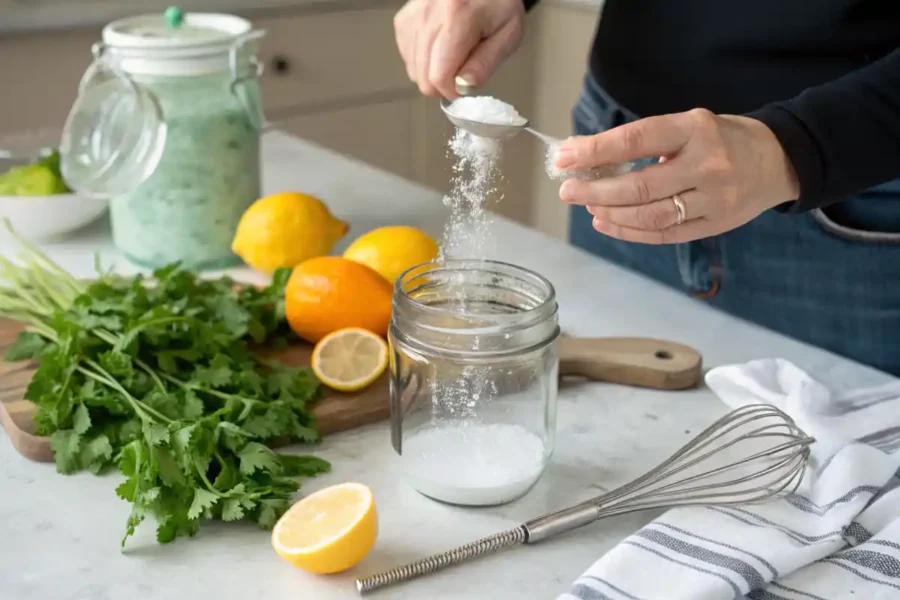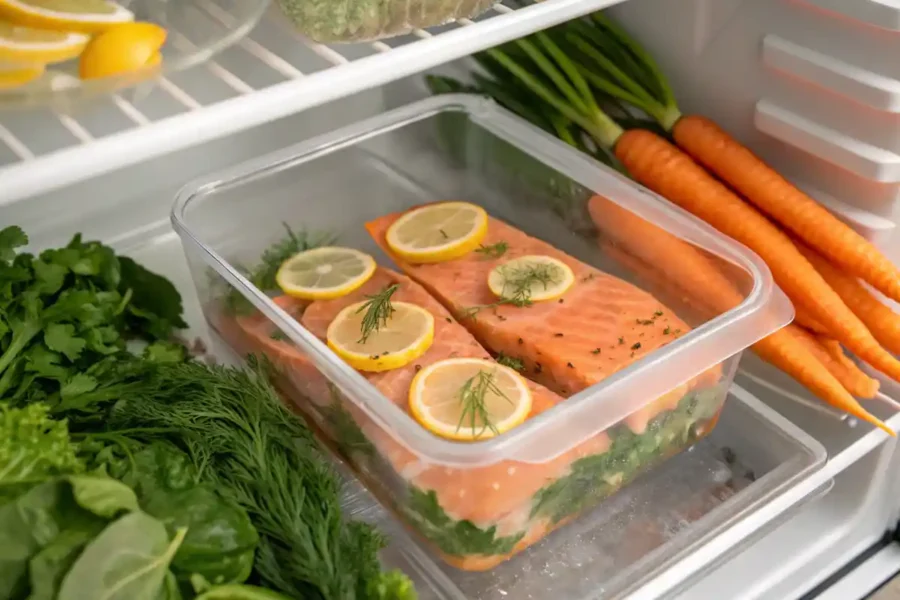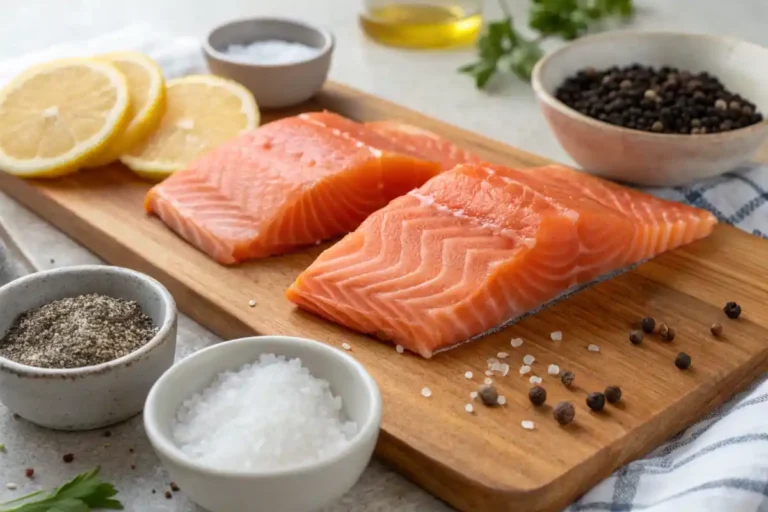Brining salmon is a culinary game-changer, unlocking flavors, improving texture, and ensuring a moist, delicious bite every time. But the question “How long can I brine salmon?” often leaves cooks puzzled. Brining times can vary depending on the cut of the salmon, your flavor goals, and the cooking method you plan to use. Brine it too long, and you risk overpowering the delicate fish. Skip brining altogether, and you might end up with dry, bland salmon.
In this guide, we’ll dive into everything you need to know about brining salmon, including optimal brining times, tips for achieving the perfect balance, and common mistakes to avoid. By the end, you’ll be brining like a pro and impressing your guests with tender, flavorful salmon!
Table of Contents
Understanding the Basics of Brining Salmon
What Is Brining and Why Is It Important for Salmon?
Brining is the process of soaking food in a solution of water, salt, and sometimes sugar or spices. This method doesn’t just season the fish; it also enhances its texture and moisture content. When you brine salmon, the salt penetrates the fish’s cells, drawing in water and locking in moisture. This makes the fish juicier and more resistant to drying out during cooking or smoking.
For salmon, brining is particularly valuable because it complements the fish’s delicate flavor while protecting it from the intense heat of hot-smoking or the drying effects of cold-smoking. In short, brining is the secret weapon for tender, flavorful salmon.
The Role of Brining in Enhancing Flavor and Texture
Brining does more than just hydrate the salmon. It enhances the fish’s natural taste by infusing subtle flavors from herbs, spices, or citrus added to the brine. Additionally, brining creates a firmer texture by breaking down proteins in the fish, giving it that perfect, silky bite.
Without brining, salmon can easily lose its moisture during cooking, leaving you with a dry and lackluster dish. That’s why understanding how long can I brine salmon is crucial it ensures you get all the benefits without compromising the fish’s quality.
Factors That Affect Brining Time
Brining time isn’t a one-size-fits-all process. The optimal duration depends on factors like the thickness of the salmon, the salt concentration in the brine, and whether you’re using hot or cold-smoking techniques. For example, thinner fillets may only need 6–8 hours, while whole salmon can take up to 24 hours. Adjusting brining time based on these factors is key to achieving the perfect balance of flavor and texture.
Next, we’ll explore how brining times differ for various cuts of salmon and cooking methods. Stay tuned!
Ideal Brining Times for Different Salmon Cuts
Brining Times for Thin Fillets, Steaks, and Whole Salmon
The brining time for salmon largely depends on the cut and thickness of the fish. Thin fillets, which are more delicate, usually require a shorter brining time of 6–8 hours to avoid becoming overly salty. Salmon steaks, being thicker, can benefit from 8–12 hours of brining, allowing the solution to fully penetrate and enhance the flavor. Whole salmon, which has the most mass, can take up to 24 hours in the brine for optimal results.
It’s crucial to monitor the time carefully, as over-brining can lead to an overpowering saltiness. When in doubt, start with a shorter brining period and adjust as needed.
Hot-Smoking vs. Cold-Smoking: Does Brining Time Change?
The cooking method also impacts how long you should brine salmon. For hot-smoking, where the fish is exposed to higher temperatures, brining times tend to be shorter (6–12 hours) since the heat further intensifies the flavors. For cold-smoking, which uses lower temperatures, longer brining times (up to 24 hours) are preferable to ensure the fish absorbs enough flavor and retains moisture throughout the process.
These adjustments allow you to tailor your brining process to suit the final dish, ensuring the salmon is both flavorful and tender.
What Happens If You Brine Salmon Too Long?
Signs of Over-Brined Salmon and How to Fix It
Over-brining salmon can lead to a texture that’s too firm and a flavor that’s overly salty. The fish may also develop a rubbery feel, making it less enjoyable to eat. If you suspect you’ve brined your salmon for too long, don’t worry there are ways to salvage it.
Rinse the salmon thoroughly under cold water to remove excess salt from the surface. You can also soak the fish in fresh water for 30–60 minutes to help balance the flavor. This step often restores some of the salmon’s natural taste.
Understanding the Salt and Texture Balance
The key to avoiding over-brining is finding the right balance between salt concentration and brining time. Higher salt concentrations require shorter brining periods, while lower concentrations allow for longer soaking times. Using the recommended ratio of 1 cup of salt per gallon of water is a great starting point for most brine solutions.
Does Over-Brining Ruin the Flavor?
While over-brining can affect the flavor, it doesn’t necessarily ruin the salmon. Proper rinsing and creative seasoning can mask some of the saltiness, allowing you to salvage the dish. However, to avoid this situation altogether, always set a timer and stick to the recommended brining times based on the cut of the salmon.
For further ideas on preparing brined salmon, check out recipes like Tasty Sara’s Salmon Rice Bowl Recipe for inspiration.
Tips for Monitoring and Managing Brining Time
Using a Timer for Precision
One of the easiest ways to ensure your salmon is brined perfectly is by setting a timer. Whether you’re preparing thin fillets or a whole salmon, precise timing prevents over-brining, which can lead to an overly salty or firm texture. Use kitchen timers or smartphone alarms to remind yourself when it’s time to rinse and remove the fish from the brine.
For those wondering how long can I brine salmon, timers take the guesswork out of the process, ensuring every batch turns out flavorful and tender.
How to Test Brine Strength and Flavor
The strength of your brine significantly impacts how long you can safely brine salmon. Before submerging the fish, taste the brine to gauge its saltiness. A good rule of thumb is that the brine should taste salty but not overpowering. If it’s too strong, dilute it with water to maintain the balance.
For added flavor, experiment by steeping herbs, citrus, or spices in hot water before cooling the brine. This simple trick infuses your salmon with subtle, complementary tastes without increasing brining time.

Adjusting Brining Times for Marinades and Dry Brines
If you’re using a marinade or dry brine instead of a wet brine, the timing will differ. Dry brines, which involve rubbing salt and spices directly onto the fish, typically require less time about 4–6 hours for fillets and up to 12 hours for whole salmon. Marinades, especially those with acidic components like citrus or vinegar, may work faster but require careful monitoring to avoid over-curing.
Common Mistakes to Avoid While Brining Salmon
Over-Brining vs. Under-Brining: Striking the Right Balance
Finding the sweet spot between over-brining and under-brining is crucial for great results. Over-brining leads to overly salty fish, while under-brining results in bland flavors and uneven texture. A reliable brine time for fillets is 6–12 hours, while whole salmon can brine up to 24 hours. If you’re unsure, brine for a shorter period and taste-test before committing to a longer soak.
Skipping the Rinse Step After Brining
After brining, rinsing the salmon under cold water is a must. This step removes any excess salt from the surface, preventing the fish from tasting overly salty. Always pat the fish dry with a paper towel after rinsing to ensure a smooth cooking or smoking process.
Using Inappropriate Containers for Brining
The container you choose for brining matters more than you might think. Avoid metal containers, as they can react with the brine and impart unwanted flavors to the salmon. Instead, opt for glass, plastic, or food-safe bags. Ensure the salmon is fully submerged in the brine for even flavor distribution.
To enhance your cooking skills further, check out Tasty Sara’s Salmon Rice Bowl Recipe, which pairs beautifully with perfectly brined salmon.

Creative Ways to Serve Brined Salmon
Pairing Brined Salmon with Fresh Ingredients
Brined salmon is incredibly versatile and pairs well with a variety of fresh ingredients. Serve it alongside a crisp green salad, avocado slices, and a light vinaigrette for a refreshing meal. For a heartier option, pair it with roasted vegetables or wild rice for a well-rounded dish.
If you’re feeling adventurous, use brined salmon to create sushi rolls or poke bowls. The enhanced flavor from the brine elevates these dishes, making them crowd-pleasers for any occasion.
Brined Salmon in Gourmet Dishes
Looking for something elegant? Use brined salmon as the centerpiece of a charcuterie board, alongside cheeses, nuts, and fruit. Alternatively, create canapés by layering thin slices of brined salmon on crackers with cream cheese and fresh dill.
For breakfast, brined salmon shines in classic dishes like bagels with cream cheese and capers or as a smoky addition to scrambled eggs. No matter the meal, brined salmon brings a gourmet touch that’s both delicious and satisfying.
Health Benefits of Brined Salmon
How Brining Enhances Salmon’s Nutritional Value
Brining salmon doesn’t just improve flavor; it also helps preserve the fish’s natural nutrients. Salmon is rich in omega-3 fatty acids, which support heart health, reduce inflammation, and promote brain function. By keeping the fish moist, the brining process ensures these vital nutrients remain intact during cooking or smoking.
Adding ingredients like fresh herbs, citrus zest, or garlic to your brine can enhance the salmon’s health benefits. These additions introduce antioxidants and vitamins, giving your brined salmon an extra nutritional boost.
Why Brined Salmon Is a Healthier Choice
Brined salmon is a healthier alternative to heavily seasoned or processed options. The controlled use of natural ingredients in the brine minimizes additives and retains the salmon’s clean, wholesome flavor. Whether you serve it grilled, smoked, or baked, brined salmon pairs beautifully with fresh vegetables and whole grains for a balanced, nutrient-packed meal.
For those wondering how long can I brine salmon to maximize both flavor and nutrition, sticking to the recommended times (6–12 hours for fillets and up to 24 hours for whole salmon) ensures the best results.
Creative Serving Ideas for Brined Salmon
Incorporating Brined Salmon into Everyday Meals
Brined salmon is incredibly versatile and can elevate even the simplest meals. Use it as a topping for salads or mix it into pasta for a quick dinner. For a light lunch, serve brined salmon on a bed of quinoa with roasted vegetables and a tangy dressing.
If you enjoy wraps, try layering brined salmon with avocado, cucumber, and a dollop of tzatziki in a soft tortilla. The smoky, tender salmon adds a gourmet touch to any meal.
Brined Salmon for Special Occasions
For special occasions, brined salmon works beautifully as an appetizer or main dish. Slice it thinly and serve on toasted crostini with cream cheese and capers, or pair it with crackers and fresh dill for an elegant starter. As a main course, brined salmon can be paired with a white wine reduction and steamed asparagus for a restaurant-quality dish.
FAQs About Brining Salmon
Should I Brine My Salmon Before I Smoke It?
Yes! Brining is a crucial step when smoking salmon. It enhances flavor, ensures the fish retains moisture, and helps achieve a firm yet flaky texture. For those asking, “How long can I brine salmon?”, the answer depends on the cut fillets typically need 6–12 hours, while whole salmon can benefit from up to 24 hours in the brine.
How to Make Brine Solution for Salmon?
A standard brine solution includes water, salt, and sugar in a 1:1:1 ratio per gallon of water. Additional ingredients like citrus zest, dill, or black peppercorns can be added for extra flavor. Make sure the brine is cooled before submerging the salmon to prevent partial cooking. For detailed steps, explore recipes on brining techniques to master your approach.
Is Brining Salmon Worth It?
Absolutely! Brining transforms salmon by intensifying its natural flavor while keeping it tender and juicy. Whether you’re preparing it for smoking, grilling, or baking, brining ensures a restaurant-quality finish that impresses every time.
What Are the Signs of Properly Brined Salmon?
Properly brined salmon should feel firm to the touch but not rubbery. Its color may deepen slightly, and the surface will have a light sheen. Over-brined salmon, on the other hand, might taste overly salty or have a dry texture after cooking. Sticking to the recommended brining times helps achieve the perfect balance.

